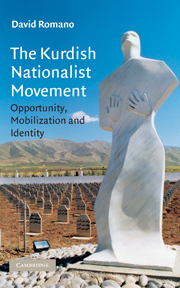Book contents
- Frontmatter
- Contents
- Acknowledgments
- List of acronyms and abbreviations
- Map
- 1 Making sense of ethnic nationalist resurgence
- 2 Structural conditions and political opportunities
- 3 Resource mobilization and rational choices
- 4 Cultural framing
- 5 Theoretical synthesis
- 6 Kurdish nationalist challenges to the Iraqi state
- 7 Kurdish nationalist challenges to the Iranian state
- 8 Conclusion
- Bibliography
- Index
- Cambridge Middle East Studies 22
1 - Making sense of ethnic nationalist resurgence
Published online by Cambridge University Press: 14 January 2010
- Frontmatter
- Contents
- Acknowledgments
- List of acronyms and abbreviations
- Map
- 1 Making sense of ethnic nationalist resurgence
- 2 Structural conditions and political opportunities
- 3 Resource mobilization and rational choices
- 4 Cultural framing
- 5 Theoretical synthesis
- 6 Kurdish nationalist challenges to the Iraqi state
- 7 Kurdish nationalist challenges to the Iranian state
- 8 Conclusion
- Bibliography
- Index
- Cambridge Middle East Studies 22
Summary
Introduction
Throughout today's world, ethnic minorities are mobilizing along ethnic nationalist lines, demanding power and recognition as a group from the states in which they live. In some cases, they are demanding a state of their own, based on their group's status as a nation of its own. These challengers to the states in which they live are often brutally suppressed, yet mobilization often continues in the face of this repression. Why, despite the high risks involved and the often remote chances of success, have such movements continued to emerge?
Contextually specific accounts of ethnic nationalist resurgence typically lack much of a theoretical component. The historical details of specific cases are thought to present an “obvious” explanation for the conflict – “group ‘X’ was oppressed, dissatisfied, or simply in a position to wrench more power from the state, which it then tried to go about doing in the following way …” forms a common approach to the subject. The fact that we can probably find a vast array of injustices, grievances, and relative deprivation affecting ethnic minorities in every society on the planet, yet few ethnic minority groups mobilize for change, is left unexplained. Approaches that are more theoretical often focus so much on one element of the phenomenon (such as socio-political structures in society, movement strategies, or identity struggles) that the resulting account leaves out more than it explains.
- Type
- Chapter
- Information
- The Kurdish Nationalist MovementOpportunity, Mobilization and Identity, pp. 1 - 24Publisher: Cambridge University PressPrint publication year: 2006

